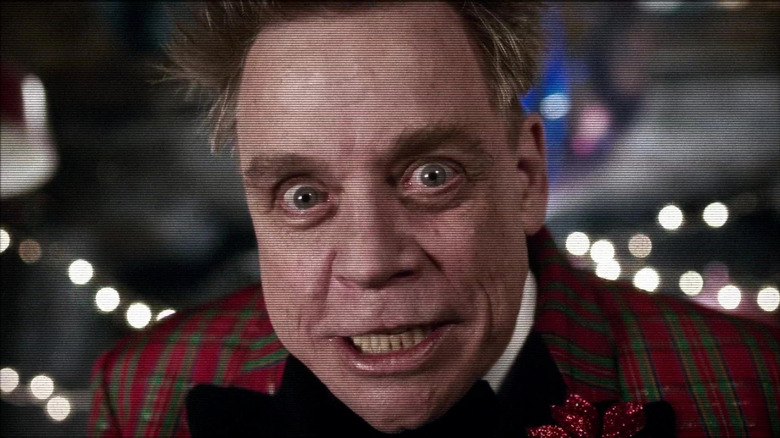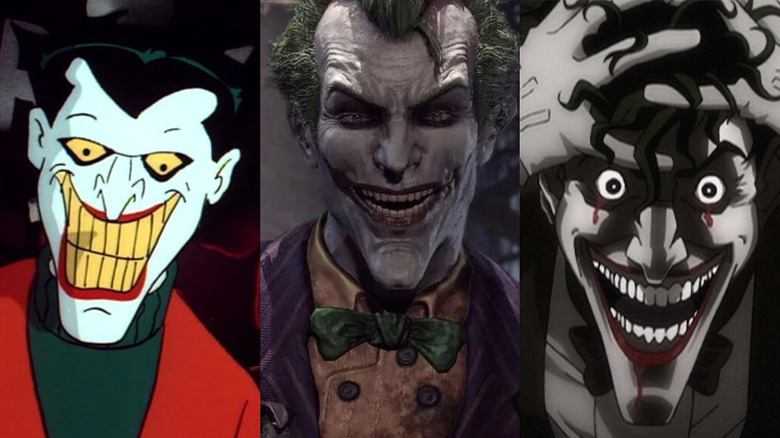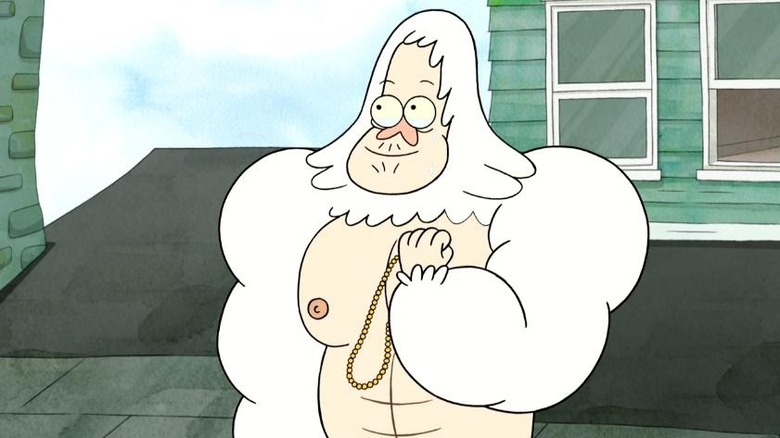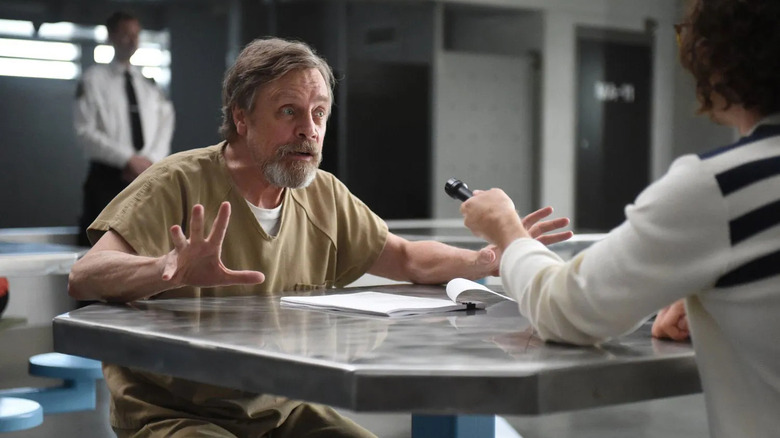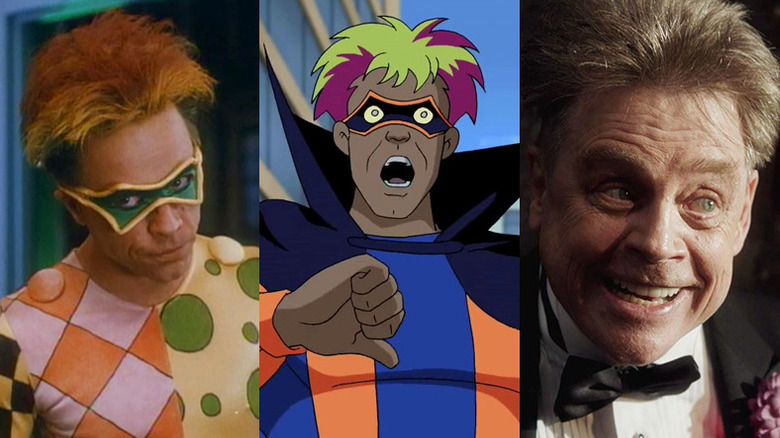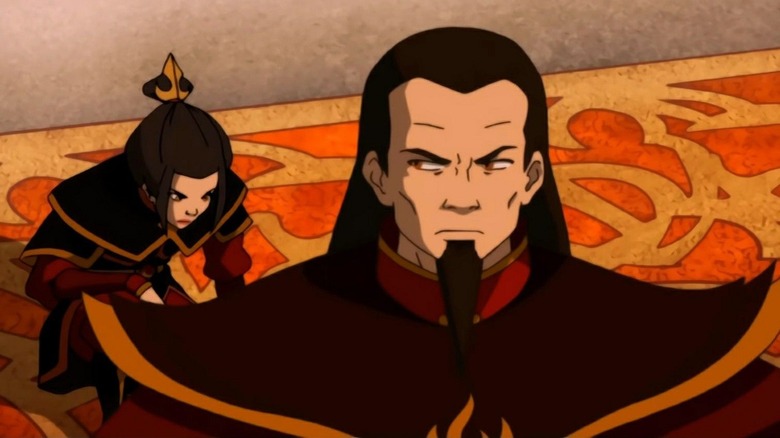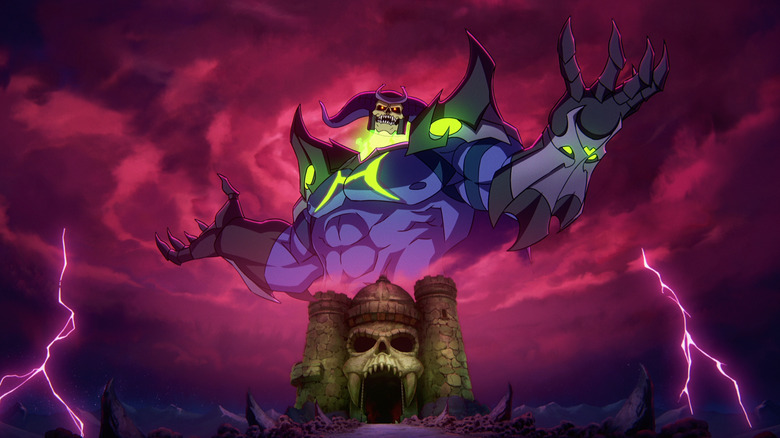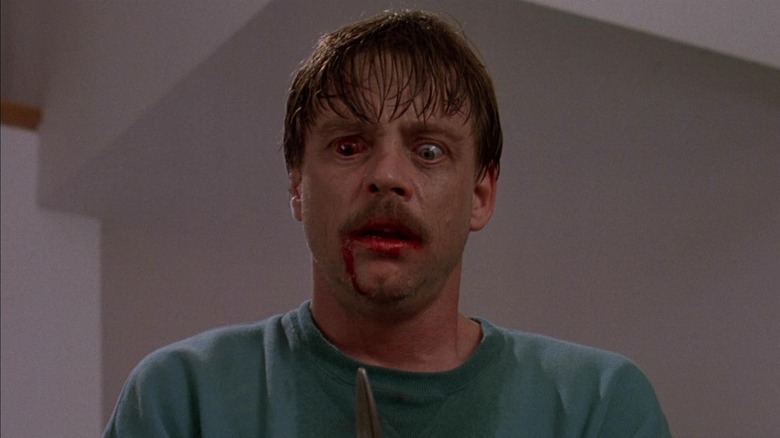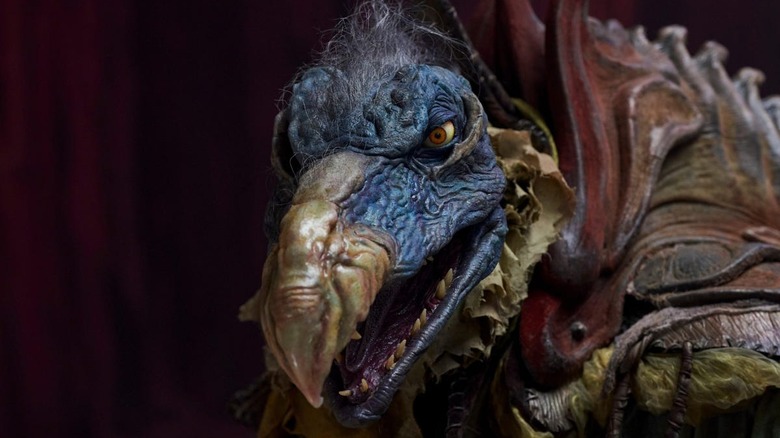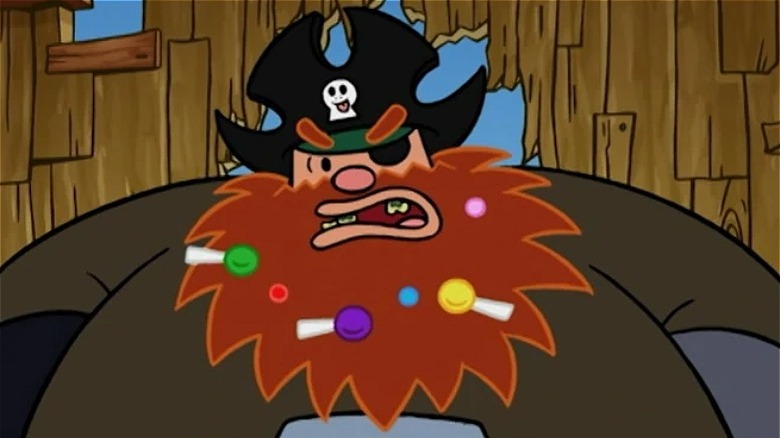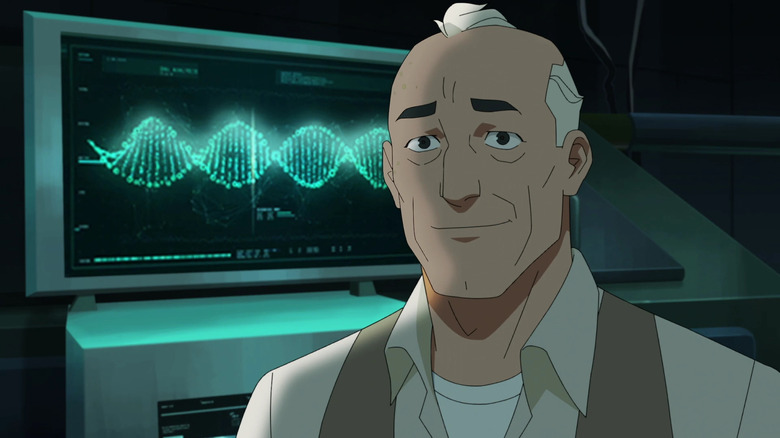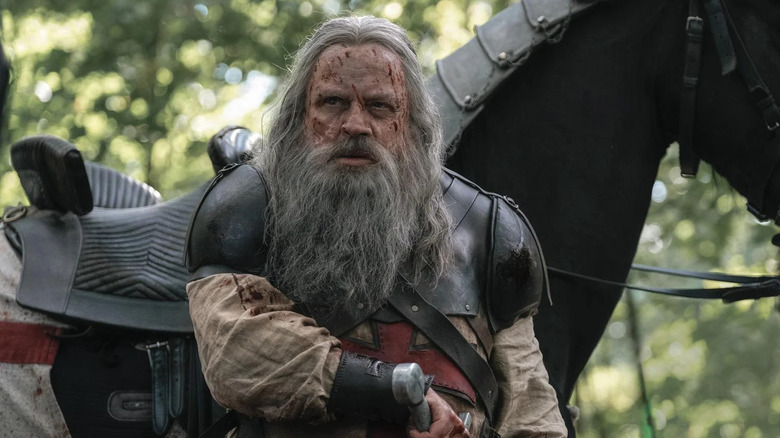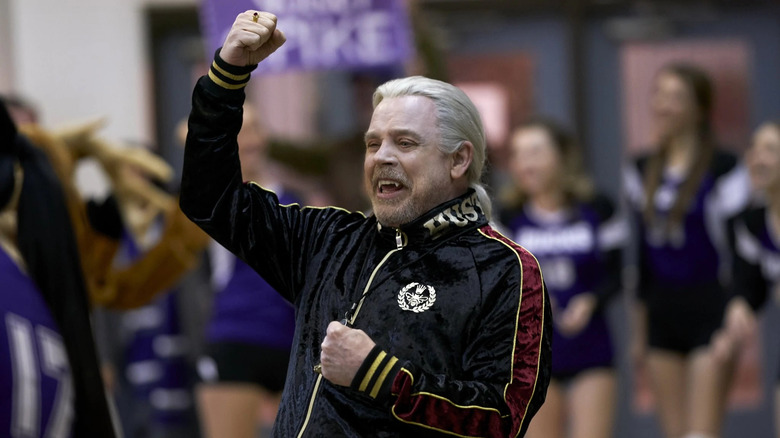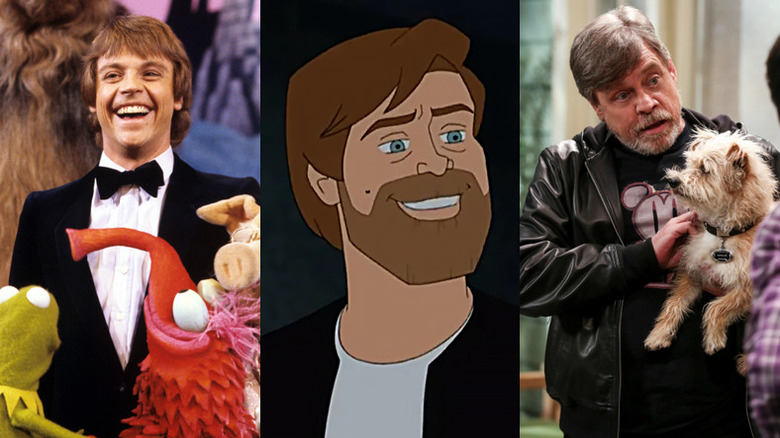The 13 Best Mark Hamill Roles That Aren't Luke Skywalker
It's impossible to deny that Mark Hamill as "Star Wars" hero Luke Skywalker is one of the most iconic performances in all of pop culture. Even amidst the franchise's most divisive era, Hamill's star power alone unites most of the fandom in love and admiration. However, to purely define the actor's abilities by his time in a galaxy far, far away would undermine an over 50-year career spanning countless genres, mediums, styles, and franchises.
Hamill began his career as a television actor, guest-starring on numerous shows throughout the '70s, and even playing a recurring role on the well-known soap opera "General Hospital." He also began what would become a storied career in voice acting, lending his talents to two Hanna Barbara productions. Though things would explode following the premiere of "Star Wars" in 1977, Hamill continued to expand his resume with projects ranging from superhero cartoons to war dramas to even horror anthologies.
Over the years, Hamill has become a go-to talent for portraying iconic villains. He's instantly recognizable with just a cackle, but still versatile enough to capture each foe's uniquely devious qualities. Whether it's stepping into the well-worn shoes of a fan-favorite character or originating his own dastardly foe, Hamill brings 100% commitment to every line and gesture. It's what makes him one of the most beloved figures in all of nerddom. For now, let's leave our lightsabers behind and reflect on just some of Mark Hamill's other most memorable roles.
The Joker (several incarnations)
I mean, duh! This article might as well have been called "The 13 Best Mark Hamill Roles That Aren't Luke Skywalker and the Joker," but we won't pass up an opportunity to stroll down memory lane with the Clown Prince of Crime. Many actors have provided beloved interpretations of Batman's archnemesis, but arguably none have done it as well (or as often) as Hamill. Spanning over 15 different projects across film, television, and gaming, Hamill has returned to the Harlequin of Hate time and time again to great acclaim. It all began with the quintessential "Batman: The Animated Series," in which Hamill synthesized Cesar Romero's kooky levity with Jack Nicholson's devilish menace to create a version of the character all his own. Despite its novelty, he never lost the character's love for chaotic theatrics — I mean, have you heard that brilliant laugh?
Like any strong character, Hamill's take on Mr. J has evolved over time – he tries to reinvent the Joker whenever he plays the villain. Hamill was asked to reprise the role in Rocksteady Studios' video game "Batman: Arkham Asylum," where he infused a sinister darkness into the character's manipulation. That trait is also evident in "Batman: The Killing Joke," the divisive adaptation of Alan Moore's seminal Joker comic, featuring what is perhaps Hamill's seediest, most dramatic take on the character yet. However, he'll still have fun with the character, as seen in shows like "Justice League Action" and even "Robot Chicken." Hamill has earned his reputation as the definitive Joker.
Skips (Regular Show)
With 261 episodes, "Regular Show" is one of Cartoon Network's longest-running shows of all time. Its popularity is largely thanks to the show's many offbeat — but lovable — characters, and Skips is no exception. Sure, he may be an immortal yeti who skips instead of walks, but he's also deeply relatable. Despite a hardened exterior, Skips is dedicated to helping his friends however he can, even if it means arm wrestling Death himself. He's the park's resident handyman, a hot wings spice lord, and even a talented bowler. In one form or another, everyone has a Skips in their life.
Skips usually represents a more grounded — maybe even cynical — perspective within the group, so it makes sense Mark Hamill brings him to life by dipping deep into his lower register. It's a gravelly voice that reflects years of experience, providing great contrast against many of the show's higher-pitched characters. It's likely not the easiest to perform for hours in the booth, yet Skips is featured in almost every episode of the show. In fact, his backstory is one of the show's most thorough, unwound over a scattering of episodes across multiple seasons. It notably culminates in "Skips' Story," in which it is revealed Skips' name used to be Walks but was changed in honor of his one true love, Mona, whom he often would skip with. After dying at the hands of Klorgbane, an immortal school bully, Skips vowed to ... well, skip for the rest of his immortal life. It's an episode that showcases Hamill's ability to be incredibly emotional and expressive with a voice that, in many other shows, would be used as kitsch.
Ted (Brigsby Bear)
Alongside an extensive career in animation, Mark Hamill has plenty of juicy live-action roles that do not get as much love as they should. Case in point: "Brigsby Bear" is an oft-forgotten low-budget comedy from the minds of "SNL" writer Dave McCary and former cast member Kyle Mooney. It stars Mooney as James, an adult man living with his parents in an underground bunker, only to learn that he was abducted as a baby. During his time in the bunker, he is obsessed with a children's space opera, "Brigsby Bear," which turns out to have been fully conceived and produced by his false father, Ted, portrayed by Hamill. It's a brilliant case of meta-casting on multiple levels, using Hamill's status as an icon of sci-fi and fantasy to deepen its commentary on the line between obsessive fandom and artistic gratification.
Though Hamill does provide some voice work as the titular character (again, great casting), his greatest moments are as Ted himself. He generates sympathy for a quietly disturbing character, presenting him as having a strong, fatherly voice and demeanor. Hamill usually inhabits darkness through outlandish caricatures with exaggerated voices, but Ted is a soft presence with silky smooth pipes — you almost forget that he's the closest thing the film has to a villain (not counting Sun Snatcher). During one of the film's final scenes, where James confronts Ted in prison, you are almost convinced Ted would make a good father had he not abducted a child to become one. It's a tender, introspective moment that is quaintly undermined by James asking Ted to provide the voices for his "Brigsby Bear" short film. That surreal cognitive dissonance makes "Brigsby Bear" a hidden gem in the coming-of-age genre.
James Jesse/The Trickster (multiple iterations)
Before he was the Joker, Mark Hamill was the Trickster aka James Jesse. One of the Flash's longest-standing foes, the Trickster role allowed Hamill to showcase a different side of his acting range. Still entrenched in the public eye as Luke Skywalker, Hamill used his clean-cut persona to his advantage, surprising audiences with a more maniacal mainstream role in 1990's "The Flash" television series. Who could forget that amazing multi-patterned leotard?
Though some DC fans will be quick to point out similarities between the Joker and the Trickster, Hamill's performances make them distinct. While both are mischievous and delight in the use of a prop gag, James Jesse is more of a lost child in a man's body. This is not only reflected in his more sophomoric weapons ("It's a snot gun!") and master-of-disguise abilities, but also in Hamill's tortured performance. In the end, all he wants is to be loved, though he delusionally seeks it out through kidnapping, torture, and mind control. This is delicately explored in "Justice League Unlimited," where the Flash consoles the Trickster after a gang of supervillains abandons him.
Like the Joker, Hamill has gone on to play the Trickster several times, most notably in "The Flash" on The CW. In his older age, Hamill initially grounds the character — think if the Trickster became Hannibal Lecter — only to let loose when he busts out of Iron Heights Penitentiary. It is great fun to see Hamill reunite with John Wesley Shipp, the original Flash from 1990, in "Tricksters," but the character really shines in his second appearance, "Running to Stand Still." This Christmas-themed episode sees Trickster teaming up with Weather Wizard, decked out in a Santa suit during the climax.
Fire Lord Ozai (Avatar: The Last Airbender)
"Avatar: The Last Airbender" remains one of the most epic stories ever told within both the mediums of animation and children's television, so much so that people are still attempting to replicate its success. Despite having lighthearted energy in its early episodes, what made it so unique was its understanding of the danger and stakes built around its mythical world.
A lot of this came down to the show's big bad, Fire Lord Ozai, the strongest firebender in all the Four Nations, and a power-hungry tyrant that sought to rule over them. He was a force to be reckoned with from the show's first opening sequence; though he doesn't formally appear until later, his impact can be felt as we explore many different locations across the first two seasons. His formal arrival as a major antagonist in Season 3 signals a far more serious tone for the show's final chapters, trading whimsy and silliness for destructive bending battles and intense interpersonal drama.
Mark Hamill is first heard in the Season 1 finale, in which Ozai commands Princess Azula to pursue Prince Zuko and Uncle Iroh. It's a fairly straightforward vocal performance from Hamill right from the get-go — his pitch sits in the lower register with a vile, gravelly effect layered in — but it distills the character's raw power so immediately that any fan of the show would shake in their boots. Once you really get to see Ozai in action, Hamill's fervent intimidation beautifully complements the character's blunt brutality and unabashed ego. It's a more forthright effort from Hamill, but Ozai is a pretty frank character; nothing wrong with simply understanding the assignment.
Skeletor/Skelegod (Masters of the Universe: Revelation)
When looking to reimagine "He-Man" for a more adult audience, it's hard to find a better pairing of talent and material than Mark Hamill and Skeletor. The original character's whiny cackling may feel a bit outdated by today's standards, but Hamill has a knack for adding darker dimensions to classic characters. Kevin Smith's far more intimidating interpretation leaps off the screen thanks to Hamill's multi-dimensional voice work, anchored by the Lord of Destruction's trademark growl, but accented with several other modes. You can hear a more airy, guttural tone when he's mocking, yet smoothed out pipes in more diabolical monologues. He even relishes in a few rolled R's here and there, presenting Skeletor as some regal ruler, despite really being a boney brat.
However, what sets this version of Skeletor apart isn't even Skeletor himself, but Skelegod. Though the antagonist takes a backseat in the show's first half, he makes a big return in the second, claiming The Power for himself and becoming a Master of the Universe. As silly as it sounds, Skelegod goes hard; his design gets a massive upgrade, sporting demon horns and a burlier build, and his levels of sorcery reach unprecedented levels. For a moment, you're convinced that not even a bumbling henchman could thwart his plot this time. One series highlight sees Skelegod battling Savage He-Man, a Hulk-esque version of Adam who has been infused with The Power, but without the Power Sword to channel it. It's a delightfully destructive rage fest that, like this version of Skeletor, gives a previously meme'd IP some serious heft.
Brent Matthews (Body Bags)
You may not think of Mark Hamill as a horror actor, but when he gets to play in that sandbox, he makes every credit count. He put his own spin on yet another iconic villain, Chucky in 2019's "Child's Play" remake (where his performance earned praise from Stephen King). However, even earlier in his career, Hamill was working with legends. He has an uncredited cameo in King's "Sleepwalkers," and Tobe Hooper would direct him in the horror anthology "Body Bags," a collaboration between Hooper and John Carpenter.
"Body Bags" tells three stories, each one inspired by a different dead body recently sent to the morgue. The first two tales, "The Gas Station" and "Hair," are directed by Carpenter, but Hooper helms the final segment, "Eye." Hamill plays Brent Matthews, a successful baseball player who pierces his eye in an ugly car accident. After a doctor performs experimental surgery to fully replace his eye, Matthews begins experiencing terrifying visions of the eye's former owner, a deranged serial killer. These visions begin to affect his relationship with his wife, Cathy, right as they are expecting their first child.
It's an absurd concept taken to its extremes, but Hamill is up for the challenge. Matthews begins as a humble, religious Southern boy, but devolves into an uncontrollable vessel for violence. Hamill does well bouncing between the two sides of Matthews, letting himself go for the segment's devastating climax. Credit is also due to the film's writers, Billy Brown and Dan Angel, who tie Matthews' spirituality into a brilliant final beat involving scripture. Oh, and shout out to Carpenter, who portrays a coroner in between the three segments. What an icon.
The Scientist/skekTek (The Dark Crystal: Age of Resistance)
It's unclear who asked for "The Dark Crystal: Age of Resistance," an expansive prequel series to the original Jim Henson cult classic, but it manages to give us some of Hamill's most Shakespearean work. Hamill gives voice to the Scientist, also known as skekTek, one of the wretched Skeksis who rule over the mythical land of Thra. Despite the Skeksis being an ensemble of baddies, the Scientist is an especially important player in the series' story and is heavily involved in the Skeksis' fascistic intrigue.
The Scientist is vastly more intelligent than his fellow Skeksis, yet is treated with little respect or patience. Stuck with a chip on his shoulder, he becomes easily taken advantage of. However, he rises in the ranks after discovering that the Crystal of Truth can be powered by absorbing Gelfling essence. His fellow Skeksis abuse this new discovery, leading the Scientist to push his experiments further and further until it becomes out of his control and, eventually, inspires a Gelfling uprising. This pushes the Scientist to invent an army of Garthim, which leads directly into the events of the original film.
"Age of Resistance" adds many layers of humanity to the Skeksis, Hamill especially giving a greater depth to the Scientist, previously voiced by Steve Whitmire. It may be one of his growlier performances, but it's all channeled into the character's many dimensions: his constant frustrations, his curiosity toward innovation, and even his previous friendship with Mother Aughra. It all shines through in Hamill's portrayal, but deep respects must be paid to the character's puppeteer, Olly Taylor. A Henson character is nothing without their physicality, and Taylor gives skekTek a slimy, hulking presence that commandeers the screen.
Stickybeard (Codename: Kids Next Door)
Mark Hamill should play more pirates. His raspy vocal chops make him apt for a 'patch and peg leg, only proven by his time as the stickiest pirate to ever sail the seven suburbs. "Codename: Kids Next Door," often abbreviated as "KND," had a wonderfully diverse rogues gallery, but Stickybeard was particularly delicious. Captain of a candy pirate crew aboard his ship The Sweet Revenge, he's a lover of all things sugarcoated and cavity-conducive. He is often at war with the KND over stashes of delectable candy, though he's also partial to a sparkling box of Rainbow Munchies.
Stickybeard has a particular rivalry with Numbah 5, an equally avid purveyor of sweets. Beyond both of them wanting each others' candy, perhaps Numbah 5 also resents Stickybeard for mentoring her candy-hunting ex-partner, Heinrich von Marzipan. The two of them used to be thick as thieves, literally, but a botched ritual in Guatemala made them cut ties. Despite this, Numbah 5 still loves Heinrich, going so far as to team up with Stickybeard to save him from a crop of Black Licorice pirates. Stickybeard's entanglement in this friendship makes him a series highlight, even if it resolves without him (Heinrich is revealed to be Henrietta in one of the most surprisingly transcoded moments in children's television).
Hamill is surprisingly unrecognizable as Stickybeard. Despite the role playing to his strengths, Hamill's commitment to sounding like the prototypical buccaneer disguises his iconic sound. He still invigorates the character with plenty of energy though, especially when he's demolishing a mountain of candy. He even gets to highlight his singing voice in "Operation L.I.C.O.R.I.C.E.," though he's always a bit ahead of the beat.
Art Rosenbaum (Invincible)
Believe it or not, Mark Hamill doesn't always play the villain. Despite a storied career of evil, sometimes Hamill's most effective work is when he voices a character who acts for the greater good. Despite only being featured in a few scenes, it can be argued that Hamill as Art Rosenbaum is one of the most soulful performances in "Invincible," which is saying a lot, considering the series is filled with some of the most tender and heartbroken vocal work you'll hear in streaming. Personal tailor to several superheroes and an especially close friend to Omni-Man, Art Rosenbaum begins the series as blissfully unaware as anyone else. You're instantly charmed by his quelled boomer energy, especially after designing Mark Grayson's killer costume.
When Art discovers remains from the Guardians of the Globe on Omni-Man's suit, their entire friendship is turned upside down. Watching them drink together in Episode 6 is one of the series' most taut moments; Art is forced to keep his cool sitting next to his best friend, now revealed to be a monster, while Omni-Man is any second away from suspecting Art of treason. Hearing Hamill's traditional growl subdued into fear and hesitation is quietly devastating knowing his previous work. There's usually a sense that Hamill is having tons of fun when he's in the booth; here, however, he restrains himself to perfectly capture Art Rosenbaum's remorse and despair. Shout out to the music supervisors as well, who often pair Art (and his liquor) with the lush but lovelorn harmonies of '50s and '60s pop groups.
Master Talus (Knightfall)
You may not know about "Knightfall," a short-lived show from the History Channel exploring the rise and fall of the Knights Templar, but it featured what is perhaps Mark Hamill's grizzliest role to date. The show centers on Landry de Lauzon, portrayed by Tom Cullen, a Templar who leads a revival in the order following the re-emergence of the Holy Grail in France. "Knightfall" only lasted two seasons, but the second was graced by Hamill giving one of his only period performances, which is certainly a triumph to go out on.
After the events of Season 1, in which Landry sires a son out of wedlock with Queen Joan, the once proud Templar is deemed a sinner and stripped of his ranking. He is given the opportunity to re-enter the order, but as an initiate first. Hamill portrays his instructor, Master Talus, a no-nonsense knight who initially does not believe Landry is worthy of re-entry. However, after recognizing his steadfast spirit in training, Talus feels Landry has been reborn. Shortly after, Landry is reinstated just in time to fight alongside Talus as King Phillip declares war on the Templars.
Hamill goes all out in this historical role, decked out in period attire, and sporting long gray locks, a thick beard, and facial scars. Still, Hamill's staunch facial expressions and growling, commanding voice shine through it all. However, it wouldn't be a juicy Hamill role without its softer moments; in the third episode, "Faith," Talus reveals he was a prisoner of war after the Siege of Acre, which tested his faith. It's topped off by a great line delivery from Hamill: "When there's nothing to hold onto, hold onto your faith."
Jim the Vampire (What We Do in the Shadows)
Not enough people let Mark Hamill do bits. He's done plenty of comedy work poking fun at himself and his career, but he rarely ever gets to portray an original character doing funny ha-has with no strings attached. This makes Jim the Vampire a true rarity for Hamill, bringing him back to his roots as a one-off television guest star, but now as a character actor. He was already a fan of Hulu's hit vampire comedy "What We Do in the Shadows," so it was a no-brainer that Hamill would eventually make an appearance. However, none of us were quite ready for him to rock an ancient vampire getup, extensive makeup, and a vaguely Eastern European accent. It's an admirable commitment to the show's utter absurdity from an actor who is never afraid to get in on the joke.
Jim the Vampire is a simple character — a landlord from Laszlo Cravensworth's past who has come back seeking the final month's rent (and security deposit) over 167 years later. Laszlo, being the bugger that he is, flees the mansion to avoid paying his debt, but it doesn't take long for Jim to find him. Though Laszlo's fake alias, Jackie Daytona, is a series highlight unto itself, Jim is a formidable opponent in scene-stealing. His devotion toward the Bucks volleyball team is especially hilarious; his coaching at the end of the episode even allows Hamill some room for improv ("Don't be afraid to draw blood!"). The episode concludes with a hilarious button that leaves Jim open for a potential return, and why not? The more time we get with Hamill as a comedic talent, the better.
Himself (multiple iterations)
When you reach a certain level of fame, your celebrity persona becomes a character in and of itself. Mark Hamill is beloved by nerds all over the world for not only his beloved roles but also for his own nerdy obsessions. He's just like us, which ironically makes him a total legend. As such, many shows have used his reputation to their advantage, featuring him in guest appearances that are often a heightened version of himself. From quick cameos to even supporting roles, they usually riff on not only his star status but also his many indelible "Star Wars" moments. Who could forget him swinging flashlight-sabers with Scooby-Doo and Shaggy on "Scooby-Doo and Guess Who?" or watching him riff on the climax of "The Empire Strikes Back" in "Freakazoid!" and "Third Rock From The Sun"?
From portraying Nathan Detroit as Luke Skywalker in a production of "Guys & Dolls" in "The Simpsons" to gargling Gershwin on "The Muppet Show," Hamill is never afraid to poke fun at himself, even if the joke has been made a billion times. It shows just how devoted he is to delighting his fans, the very ones who got him where he is today. You don't agree to be sold on a "Star Wars" home shopping network for a "Saturday Night Live" sketch or agree to officiate Sheldon Cooper's wedding on "The Big Bang Theory," unless you love what you do and who you do it for. The man shows no signs of stopping any time soon, which hopefully means we'll get plenty more exciting new characters and silly cameos in the years to come.
